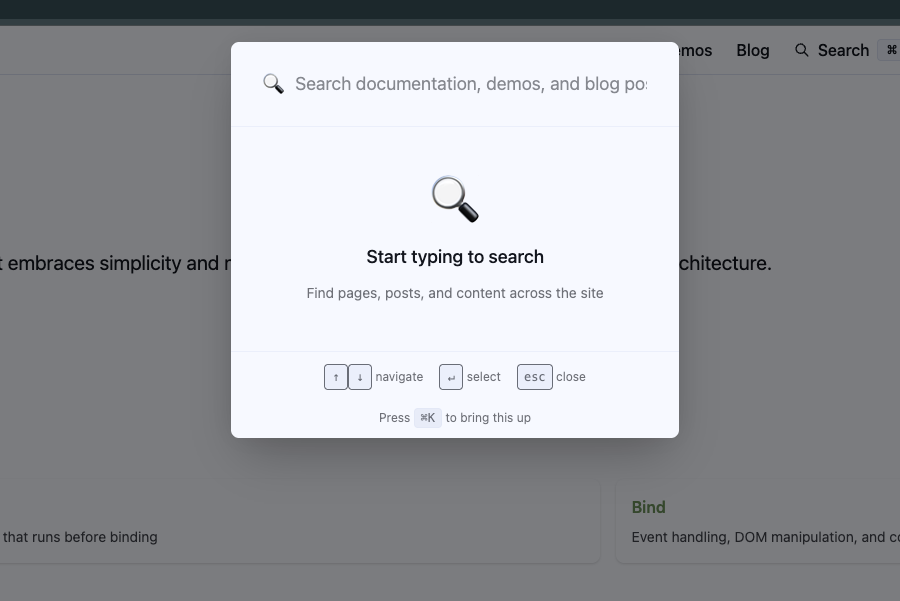Building Search into Duct - A Provider-Based Approach
Search is table stakes for modern websites. Users expect to find content instantly, whether you’re running a documentation site, blog, or application. Duct v0.8.0 introduces a flexible search system that works everywhere from static hosting to edge workers.

The Problem with Search 🔗
Adding search to a static site traditionally meant choosing between:
- Expensive third-party services with monthly fees
- Complex self-hosted solutions requiring servers
- Limited client-side search that doesn’t scale
We wanted search that’s fast, affordable, and works with modern deployment patterns.
Duct’s Solution: Provider-Based Architecture 🔗
Instead of picking winners, Duct provides a search foundation with swappable providers. Build your site once, deploy anywhere.
// duct.config.js
export default {
search: {
enabled: true,
generateIndex: true,
indexPath: 'search-index.json',
excludePaths: ['/404'],
includeContent: true
}
}
Search configuration controls index generation at build time. Provider selection happens in your components.
How It Works 🔗
Build Time: Index Generation 🔗
During static site generation, Duct crawls your content and builds a search index:
// Automatic during build
const searchIndex = {
entries: [
{
url: '/blog/post-1',
title: 'Building Search into Duct',
description: 'Search is table stakes...',
content: 'Full text content for searching',
tags: ['search', 'architecture'],
date: '2025-08-29'
}
// ... all your content
]
}
The index includes:
- Page content from markdown files
- Metadata from front-matter
- Component text content
Runtime: Provider Handles Search 🔗
Each provider implements the same interface:
interface SearchProvider<TIndexConfig = unknown> {
name: string
initialize(config: SearchProviderConfig): Promise<SearchInitializeResult>
search(query: string, options?: SearchOptions): Promise<SearchResult[]>
// Optional index management methods
index?(entries: SearchIndexEntry[], config?: TIndexConfig): Promise<void>
updateIndex?(entries: SearchIndexEntry[], config?: TIndexConfig): Promise<void>
}
Your application code stays consistent regardless of provider.
Available Providers 🔗
Client Search Provider 🔗
Perfect for smaller sites and development:
// Component initialization
import { ClientSearchProvider } from '@duct-ui/client-search-provider'
const clientSearchProvider = new ClientSearchProvider()
await clientSearchProvider.initialize({
indexUrl: '/search-index.json',
threshold: 0.3
})
- Runs entirely in the browser
- Uses FlexSearch for fast, typo-tolerant search
- No infrastructure needed
- Scales to ~1000 pages comfortably
Cloudflare Search Provider 🔗
Deploy search to the edge:
// Component initialization
import { CloudflareSearchProvider } from '@duct-ui/cloudflare-search-provider'
const cloudflareSearchProvider = new CloudflareSearchProvider()
await cloudflareSearchProvider.initialize({
workerUrl: '/api', // or your worker URL
timeout: 5000
})
- Runs on Cloudflare Workers
- R2 storage for unlimited index size
- KV namespaces for metadata
- Global edge deployment
Setup is straightforward:
# Generate worker templates
npx duct-cf-search init -o ./worker -n my-search
# Follow the instructions in the generated readme to configure the provider
...
# Deploy to Cloudflare
wrangler deploy -c worker/wrangler.toml
# Sync search index
node worker/sync-search-index.js
The Search Component 🔗
Duct includes a ready-to-use search modal:
import { SearchModal } from '@duct-ui/components'
import { createRef } from '@duct-ui/core'
const searchModalRef = createRef<SearchModalLogic>()
// In your component
<SearchModal
ref={searchModalRef}
placeholder="Search documentation..."
hotkey="k"
hotkeyCombination={["cmd"]}
on:search={performSearch}
on:select={handleSelect}
/>
Features:
- Keyboard navigation (↑/↓ to navigate, Enter to select)
- Hotkey support (Cmd+K / Ctrl+K)
- Responsive design
- Themeable
Building Your Own Provider 🔗
Creating a custom provider requires implementing the SearchProvider interface:
import type {
SearchProvider,
SearchProviderConfig,
SearchOptions,
SearchResult,
SearchInitializeResult
} from '@duct-ui/search-core'
export class MySearchProvider implements SearchProvider {
public readonly name = '@my-org/my-search-provider'
async initialize(config: SearchProviderConfig): Promise<SearchInitializeResult> {
// Connect to your search service
// Return the number of indexed documents
return { indexSize: 1000 }
}
async search(query: string, options?: SearchOptions): Promise<SearchResult[]> {
// Perform search and return results
return [
{
url: '/example',
title: 'Example Result',
excerpt: 'Matching content...',
score: 0.95
}
]
}
}
Required methods:
name: Unique identifier for your providerinitialize(): Setup connection and return index sizesearch(): Execute search and return formatted results
Optional methods:
index(): Add entries to search indexupdateIndex(): Update existing index entries
Reference implementations:
Deployment Patterns 🔗
Static Hosting (Netlify, Vercel, GitHub Pages) 🔗
Use the client provider:
- Build generates
search-index.json - Deploy with your static files
- Browser downloads and searches locally
Edge Workers (Cloudflare, Deno Deploy) 🔗
Use the Cloudflare provider:
- Build generates search index
- Deploy worker to handle search
- Sync index post-deployment
- Search runs at the edge
Traditional Servers 🔗
Build a provider for your backend:
- Index to your database during build
- API endpoint handles search
- Provider proxies to your API
Get Started with Search 🔗
Ready to add search to your Duct site? Check out our comprehensive search demo for step-by-step setup guides and configuration options.
Built a custom search provider or have an interesting search implementation? Share it in GitHub Discussions to help other developers in the community.
Conclusion 🔗
Search in Duct follows the framework’s philosophy: explicit, flexible, and predictable. Choose the provider that fits your deployment model, and upgrade as you grow. No vendor lock-in, no surprise bills, just search that works.